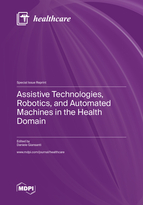Assistive Technologies, Robotics, and Automated Machines in the Health Domain
A special issue of Healthcare (ISSN 2227-9032). This special issue belongs to the section "TeleHealth and Digital Healthcare".
Deadline for manuscript submissions: closed (31 January 2023) | Viewed by 39010
Special Issue Editor
Interests: biomedical engineering; robotics; artificial intelligence; digital health; rehabilitation; smart technology; cybersecurity; mental health; animal-assisted therapy; social robotics; acceptance; diagnostic pathology and radiology; medical imaging; patient safety; healthcare quality; health assessment; chronic disease
Special Issues, Collections and Topics in MDPI journals
Special Issue Information
Dear Colleagues,
There are three high-tech elements that have the potential to make an important contribution to healthcare with their development and integration into the health domain, both as single and interconnected components: assistive technologies, care robots, and automated systems. According to the WHO, assistive technologies enable and promote inclusion and participation, especially of persons with disabilities. The main purpose of an assistive technology is to maintain or improve an individual’s functioning and independence, thus allowing them to participate in all activities in life, from education to work. The Policy Department for Economic, Scientific and Quality of Life Policies of the European Parliament identified the most interesting applications of care robots as divided into four groups: robotic surgery, care and socially assistive robots, rehabilitation systems, and training for health and care workers. Automated machines support healthcare systems in the decision-making, therapeutic, and rehabilitation approaches. Based on automated machines, the perspective of care in the health domain is radically changing with the potential to transform medicine. Automated machines, to cite a few examples: allow the avoidance of errors during therapy, as for example, in drugs interactions; support the medical decision workflows both in digital pathology and digital radiology; and work in direct contact with patients through robots and other solutions based on artificial intelligence. The development and the integration of assistive technologies, care robots, and automated machines are strategic both as single components and together, when interconnected in the health domain. Thanks to assistive technologies it is possible, for example, to implement ambient assisted living using robotics and automated machines, or to be assisted and rehabilitated at home, always with the use of robotics and automated machines. The topic is very broad and ranges from scientific development to integration in the clinic, and it also includes the regulatory, ethical, and acceptance aspects of insiders and citizens.
This Special Issue invites authors to contribute on aspects of the research, development, and integration of these technologies, both considered individually and interconnected with each other.
Potential topics include, but are not limited to:
- Assistive technologies;
- Alternative and augmentative communication;
- Rehabilitation and assistance robotics;
- Social robots;
- Automated machines;
- Artificial intelligence in biomedicine;
- Machine ethics;
- Artificial intelligence in diagnostics;
- Artificial intelligence in therapy;
- Moral robots.
For this Special Issue of Healthcare, we are interested in commentaries, original research, short reports, opinions, brief communications, and reviews on challenges in health systems focused in this field.
Dr. Daniele Giansanti
Guest Editor
Manuscript Submission Information
Manuscripts should be submitted online at www.mdpi.com by registering and logging in to this website. Once you are registered, click here to go to the submission form. Manuscripts can be submitted until the deadline. All submissions that pass pre-check are peer-reviewed. Accepted papers will be published continuously in the journal (as soon as accepted) and will be listed together on the special issue website. Research articles, review articles as well as short communications are invited. For planned papers, a title and short abstract (about 100 words) can be sent to the Editorial Office for announcement on this website.
Submitted manuscripts should not have been published previously, nor be under consideration for publication elsewhere (except conference proceedings papers). All manuscripts are thoroughly refereed through a single-blind peer-review process. A guide for authors and other relevant information for submission of manuscripts is available on the Instructions for Authors page. Healthcare is an international peer-reviewed open access semimonthly journal published by MDPI.
Please visit the Instructions for Authors page before submitting a manuscript. The Article Processing Charge (APC) for publication in this open access journal is 2700 CHF (Swiss Francs). Submitted papers should be well formatted and use good English. Authors may use MDPI's English editing service prior to publication or during author revisions.
Keywords
- eHealth
- mHealth
- assistive technologies
- automated systems
- care robots
- artificial intelligence







